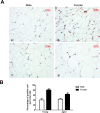An ERβ agonist induces browning of subcutaneous abdominal fat pad in obese female mice
- PMID: 27922125
- PMCID: PMC5138613
- DOI: 10.1038/srep38579
An ERβ agonist induces browning of subcutaneous abdominal fat pad in obese female mice
Abstract
Estrogen, via estrogen receptor alpha (ERα), exerts several beneficial effects on metabolism and energy homeostasis by controlling size, enzymatic activity and hormonal content of adipose tissue. The actions of estrogen on sympathetic ganglia, which are key players in the browning process, are less well known. In the present study we show that ERβ influences browning of subcutaneous adipose tissue (SAT) via its actions both on sympathetic ganglia and on the SAT itself. A 3-day-treatment with a selective ERβ agonist, LY3201, induced browning of SAT in 1-year-old obese WT and ERα-/- female mice. Browning was associated with increased expression of ERβ in the nuclei of neurons in the sympathetic ganglia, increase in tyrosine hydroxylase in both nerve terminals in the SAT and sympathetic ganglia neurons and an increase of β3-adrenoceptor in the SAT. LY3201 had no effect on browning in young female or male mice. In the case of young females browning was already maximal while in males there was very little expression of ERβ in the SAT and very little expression of the β3-adrenoceptor. The increase in both sympathetic tone and responsiveness of adipocytes to catecholamines reveals a novel role for ERβ in controlling browning of adipose tissue.
Figures








References
-
- Key T. J. et al.. Body mass index, serum sex hormones, and breast cancer risk in postmenopausal women. J Natl Cancer Inst 95, 1218–1226 (2003). - PubMed
Publication types
MeSH terms
Substances
LinkOut - more resources
Full Text Sources
Other Literature Sources
Medical
Research Materials

